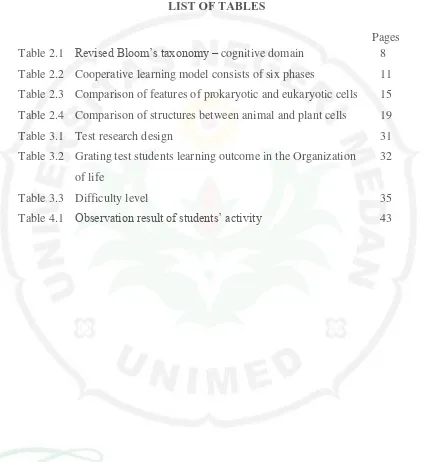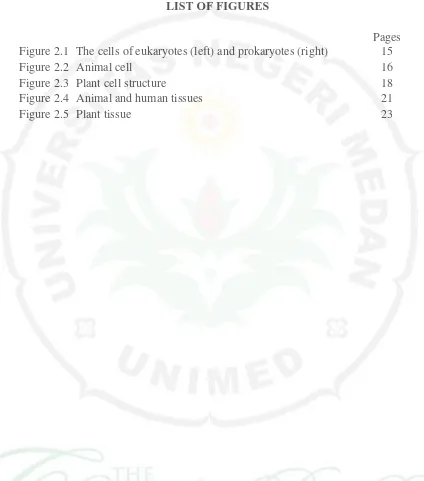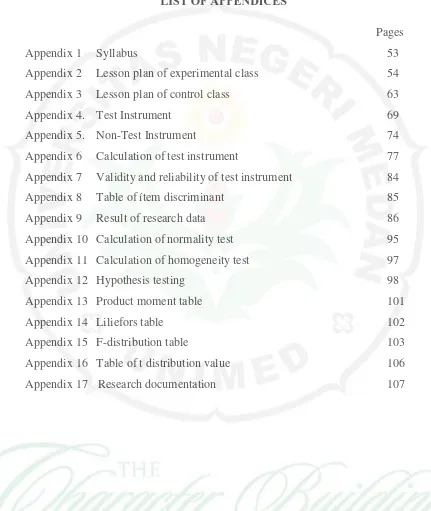BY :
Dwi Rahmanarsih SID 409342019
Biology Bilingual Education Departement
THESIS
Submitted to Fulfill One of the Requirement for the Degree of Sarjana Pendidikan
BIOLOGY DEPARTEMENT
FACULTY OF MATHEMATICS AND NATURAL SCIENCES STATE UNIVERSITY OF MEDAN
ACKNOWLEDGEMENT
Assalamualaikum. Wr. Wb.
Alhamdulillah, the deepest thank and praise the writer prayed to the Almighty God, Allah SWT for blessing hence writer is able to finish this thesis entitled “The Effect of Jigsaw Cooperative Learning Model on Students Learning Activity and Learning Outcome in Organization of Life Topic for Grade VII SMP Negeri 1 Tebing Tinggi Academic Year 2013/2014” to fulfill one of the requirement for the degree of Sarjana Pendidikan in Biology Department, FMIPA Unimed.
The writer gratefully acknowledge the deepest gratitude to Dra. Martina Restuati, M.Si as writer thesis supervisor who has generously spent precious time in giving the guidance, encouragement, comments and suggestions until this thesis comes to its present form. The enormous appreciation is addressed to Prof.Dr.rer.nat.Binari Manurung, M.Si., Drs. Tri Harsono, M.Si, and Dr. Syahmi Edi, M.Si as the examiners for their criticisms and valuable advices. The writer would also like to thank Mrs. Dra. Martina A. Napitupulu, M.Sc., as my academic advisor, Mr. Drs. Tri Harsono, M.Si. as the chairman of Biology Department, and
also to all of the lecturer and staff in Biology Major of MIPA UNIMED who helped and given motivation to me. Special thanks are extended to Mr. Drs. H.
Adrul as the headmaster SMP Negeri 1 Tebing Tinggi and Mrs. Berliana Silitonga, S.Pd, as the Biology teacher who helping the writer during the research.
v
Eka Putra Sembiring, Asri Ivo Hutahuruk, S.Pd., S.Pd., Rilly Andika, S.Pd., Siti Indriani Tambunan, S.Pd., Syamsiah Hasibuan, S.Pd., Remli Nelmian Simarmata, S.Pd., Nella Kristina Simanjuntak, S.Pd., Rina Maya Sari Purba, S.Pd., Triana Gultom, S.Pd., Wiwik Simanjuntak, S.Pd., Mawaddah Nst, S.Pd., Tresia Sihombing, S.Pd. and Nuraisyiah, S.Pd. Thank all the people who helping and supporting the writer in any other way. May Allah reward all those who have contributed in the completion of this thesis. Hopefully, this thesis will be beneficial to contribute ideas in education.
Alhamdulillahirabbil’alamin...
Medan, January 2014 Writer,
THE EFFECT OF JIGSAW COOPERATIVE LEARNING MODEL ON STUDENTS LEARNING ACTIVITY AND LEARNING OUTCOME
IN ORGANIZATION OF LIFE TOPIC FOR GRADE VII SMP NEGERI 1 TEBING TINGGI ACADEMIC YEAR 2013/2014
DWI RAHMANARSIH (409342019)
ABSTRACT
The objectives of this research are to find out: (1) the effect of Jigsaw Cooperative Learning Model on students’ activity, (2) the effect of Jigsaw Cooperative Learning Model on students’ learning outcome, in organization of life topic. A quasi experimental research with pretest and posttest control group design was used in this research. The population of this research was all of grade VII students of SMP Negeri 1 Tebing Tinggi. There were 2 classes chosen as the sample by applying cluster random sampling technique. Experimental class was taught by Jigsaw Cooperative Learning Model while control class was taught by direct instruction model. The instruments used to obtain the data were observation sheet as non-test instrument and cognitive test in form of multiple choices as test instrument. The observation results showed that students’ activity in both research classes is significantly different. The students in experiment class were more active than students in control class by the average percentage of 67.87% and 19.60% respectively. It means that Jigsaw Cooperative Learning Model gave an effect to students’ activity. The test instrument data were analyzed by using t-test. The result of hypothesis test for the pre test showed that tcount = 0.062 < ttable =
1.672 at the level significance of 0.05, means H0 is accepted and Ha is rejected. It
means that there is no significant different between pretest score in experiment class with control class. For post test showed that tcount = 5.9 > ttable = 1.72 at the
level significance of 0.05, means that Ha was accepted and H0 was rejected. It can
be concluded that there is an effect of Jigsaw Cooperative Learning Model on students’ learning outcome. Learning outcome of students that taught with Jigsaw Cooperative Learning Model showed better results than students that taught with direct instruction model. On the whole, Jigsaw Cooperative Learning Model gave good effect to students’ activity and learning outcome in organization of life topic for grade VII SMP 1 Tebing Tinggi academic year 2013/2014.
vi
TABLE OF CONTENT
Pages
Approval Sheet i
Biography ii
Abstract iii
Acknowledgement iv
Table of Content vi
List of Figures viii
List of Tables ix
List of Scheme x
List of Appendices xi
CHAPTER I INTRODUCTION
1.1 Background 1
1.2 Problem Identification 3
1.3 Problem Scope 3
1.4 Problem Questions 4
1.5 Research Objectives 4
1.6 Significances of Research 4
CHAPTER II LITERATURE REVIEW
2.1 Theoretical Framework 5
2.1.1 The Essential of Learning 5
2.1.2 Process and Learning Phase 5
2.1.3 Learning Activity 6
2.1.4 Learning Factors 7
2.1.5 Learning Outcomes 8
2.1.6 Learning Outcomes Evaluation 9
2.2. Cooperative Learning 10
2.2.1 Understanding Cooperative learning 10
2.2.2 Cooperative Learning Objectives 12
2.2.3 Jigsaw type of cooperative learning model 12
2.3 Organization of Life 14
2.4 Research Hypothesis 28
CHAPTER III RESEARCH METHODOLOGY
3.1 Location and Time 30
3.2 Population and Sample 30
3.3 Research Variables 30
3.4 Research Design 30
3.5 Research Instrument 31
3.6 Research Procedure 36
CHAPTER IV RESULT AND DISCUSSION
4.1 Result 43
4.1.1 Description of Research Data 43
4.1.1.1 Students’ Activity 43
4.1.1.2 Students’ Learning Outcome 44
4.1.2 Analysis of Research Data 45
4.2 Discussion 46
CHAPTER V CONCLUSION AND RECOMMENDATION
5.1 Conclusion 50
5.2 Recommendation 50
REFERENCES 51
ix
LIST OF TABLES
Pages Table 2.1 Revised Bloom’s taxonomy – cognitive domain 8 Table 2.2 Cooperative learning model consists of six phases 11 Table 2.3 Comparison of features of prokaryotic and eukaryotic cells 15 Table 2.4 Comparison of structures between animal and plant cells 19
Table 3.1 Test research design 31
Table 3.2 Grating test students learning outcome in the Organization 32 of life
Table 3.3 Difficulty level 35
Table 4.1 Observation result of students’ activity 43
LIST OF FIGURES
Pages Figure 2.1 The cells of eukaryotes (left) and prokaryotes (right) 15
Figure 2.2 Animal cell 16
Figure 2.3 Plant cell structure 18
Figure 2.4 Animal and human tissues 21
xi
LIST OF APPENDICES
Pages
Appendix 1 Syllabus 53
Appendix 2 Lesson plan of experimental class 54
Appendix 3 Lesson plan of control class 63
Appendix 4. Test Instrument 69
Appendix 5. Non-Test Instrument 74
Appendix 6 Calculation of test instrument 77
Appendix 7 Validity and reliability of test instrument 84
Appendix 8 Table of ítem discriminant 85
Appendix 9 Result of research data 86
Appendix 10 Calculation of normality test 95
Appendix 11 Calculation of homogeneity test 97
Appendix 12 Hypothesis testing 98
Appendix 13 Product moment table 101
Appendix 14 Liliefors table 102
Appendix 15 F-distribution table 103
Appendix 16 Table of t distribution value 106
CHAPTER I INTRODUCTION
1.1. Background
At present now a lot of criticism directed on the teachers’ way to teach which put too much emphasis on the mastery of just a number of information or concepts rather than the teaching learning process itself. In general, the process of education and teaching in schools today is still running in the classical style,
which means that a teacher in the classroom faces the number of students between 20-40 students in the same time and delivers the same learning materials as well. Teachers often use the same model to the whole students. In this classical teaching, the teachers assume that all students of the class have not different ability, different readiness and different maturity. Actually, each person has different characteristics - different from one to another one. One such individual differences is the ability, so we often found in each class that the students group that has a high, medium and low capability. Nowadays, teachers use the learning models that have not been able to appreciate and accommodate the individual differences of students. In the implementation of the learning process ,the teachers teaching by same service for all the students, whether it is for the high, medium and low ability of student. The students have different learning speeds and they can get the service of learning is depended on each of their abilities. Students who are slower still left behind, while students who are faster get the optimal service learning. This learning process that takes place in the class can not encourage students to progress and develop according to each of their abilities.
The results of researcher interviews with a Biology teacher at SMP Negeri 1 Tebing Tinggi, Mrs. Berliana Silitonga, S.Pd., learning process in class is still
2
enthusiastic following of students in learning activities. When the teacher asked, many students were not able to answer. The students ability to remember newly learned material is very low or they are quickly forget the lesson they just learned. Thus, probably it is why formative test scores of students for organization of life is still below the Kriteria Ketuntasan Minimum (KKM). KKM value in SMP Negeri 1 Tebing Tinggi at VII Class is 75, and that almost all of the students’ formative test results below the KKM and also almost all of the students were not active in the class.
There are a number of potential approach to improve this learning process and outcome, namely the teacher’s teaching approach, method or model. Cooperative learning comprises “instructional methods in which teachers organize students into small groups, which then work together to help one another learn academic content” (Slavin, 1996). Jigsaw learning, one kind of cooperative learning method developed by Aronson in Tran (2012), helps students break learning materials into manageable learning pieces, and then has students teach others the piece they have mastered, consequently combining these pieces into one whole. Jigsaw learning is based on the perspective that each student will first
become “an expert” in a small part of the whole learning material, and then teach
other students in his group this part of the material.
According to Slavin (1996), jigsaw is considered a very good model candidate to be studied since this model will improve students learning outcomes, the activities of students in the teaching, and learning process. This model is also considered suitable for a medium class size (20 up to 40 students).
The Jigsaw models were developed for narrative materials in the core content areas like social studies, science, literature, and other school subjects in which the goal is to learn concepts rather than skills by Robinson (1991).
Heterogeneous groups of students are given sections or chapters of material to read and teach "their topic" or a part of the text to others in their group. The Jigsaw models rely primarily on grade level texts and other printed materials.
they must contribute to the group in order for it to successfully complete the task at the end of the activity. Social psychologists believe that by paying attention to these group dynamics factors, educators create an environment in which students feel support from peers, an environment in which they can take risks. Such an environment is essential for thinking.
Based on the description of jigsaw model, it is suitable to apply Jigsaw Cooperative Learning Model in this class for my research. Thus, it can make the effect on student’s learning activity and learning outcome in learning process. So my research title is “The Effect of Jigsaw Cooperative Learning Model on Students Learning Activity and Learning Outcome in Organization of Life Topic for Grade VII SMP Negeri 1 Tebingtinggi Academic Year 2013/2014”.
1.2. Problem Identification
Based on the above background, the problems can be identified are as follows:
1. The learning model that is used by the teacher nowadays still can not improve students learning activity and learning outcome.
2. The student learning outcome is low, especially in biology subject. 3. Students ability to remember is low, especially in biology subject. 4. Students in the class is not active, so teaching and learning process still
very less effective.
1.3. Problem Scope
The problems of this research was limited to the students learning activities and students learning outcome. This research was limited the use of two teaching models namely Jigsaw Cooperative Learning Model and direct
4
1.4 Problem Questions
The problems with restrictions on the formulation in this research are: 1. Is there any effect of Jigsaw Cooperative Learning Model on students’
learning activity in organization of life topic for grade VII SMP Negeri 1 Tebing Tinggi academic year 2013/2014?
2. Is there any effect of Jigsaw Cooperative Learning Model on students’
learning outcome in organization of life topic for grade VII SMP Negeri 1 Tebing Tinggi academic year 2013/2014?
1.5. Research Objectives
Based on the formulation of the problem described above, the objectives of this research to find out:
1. To know the effect of Jigsaw Cooperative Learning Model on
students’ learning activity in organization of life topic for grade VII
SMP Negeri 1 Tebing Tinggi academic year 2013/2014.
2. To know the effect of Jigsaw Cooperative Learning Model on
students’ learning outcome in organization of life topic for grade VII
SMP Negeri 1 Tebing Tinggi academic year 2013/2014.
1.6. Significances of Research
The expected benefits of research in this study are:
1. For researcher, as an input and motivation to carry out the profession as a teacher.
2. For the teachers, as an input especially, for the teachers of biology in selecting appropriate learning method in learning biology.
3. For the students, this research was improve the students learning
outcome and also the students learning activities, and the students was work together in group to develop a social skill.
REFERENCES
Arikunto, S. (2010). Prosedur Penelitan Suatu Pendekatan Praktik. Jakarta: Penerbit Rineka Cipta.
Arikunto, S. (2011). Dasar-dasar Evaluasi Pendidikan. Jakarta: Penerbit Bumi Aksara.
Azizah, Nur. (2013). Pengaruh Metode Pembelajaran Jigsaw Terhadap Hasil Belajar Mata Pelajaran Dasar Kompetensi Kejuruan di SMK Wongsorejo
Gombong. Thesis. Program Studi Pendidikan Teknik Mesin Fakultas
Teknik. Universitas Negeri Yogyakarta, Yogyakarta.
Dunn, L. (2002). Theories of Learning. Oxford Centre for Staff and Learning
Development-Learning and Teaching Briefing Papers Series: 1-3.
Efe, R. and Hulya, A. (2011). Using student group leaders to motivate students in cooperative learning methods in crowded classrooms. Educational
Research and Reviews, 6 : 187-196.
Felder, R. M. and Rebecca, B. (2007). Cooperative Learning. Department of Chemical Engineering, N.C. State University, Raleigh, NC 27695-7905 Education Designs, Inc., Cary, NC 27518.
Gholami, G. (2011). The Effect of Cooperative Learning on Academicn Achievement, Journal of American Science, 7 : 596-599
Gravells, A. (2008). Preparing to Teach in the Lifelong Learning Sector. Great Britain: Bell and Bain Ltd.
Haghighi, A. 2006. Reverse-Traditional/Hands On: An Alternative Method Of Teaching Statistics. Applications and Applied Mathematics (AAM): An
International Journal. USA.
Ha¨nze a, M. And Roland, B. (2007). Cooperative learning, motivational effects, and student characteristics: An experimental study comparing cooperative
learning and direct instruction in 12th grade physics classes. Institute of
Psychology, FB 7, University of Kassel, Hollaendische Strasse 36, 34109 Kassel, Germany.
Jacobs, G. M., Lee, C, and Ng, M. (1997). Co-operative learning in the thinking classroom. Paper presented at the International Conference on Thinking, Singapore.
52
Oemar, H. (2003). Proses Belajar Mengajar. Jakarta: PT. Bumi Aksara.
Purwanto, N. (2004). Prinsip-prinsip dan Teknik Evaluasi Pengajaran. Bandung: Remaja Rosdakarya.
Robinson, A. (1991). Cooperative Learning and the Academically Talented
Student. Arkansas: University of Arkansas at Little Rock Little Rock
Rusman. (2010). Model Pembelajaran Mengembangkan Profesionalisme Guru.
Jakarta: Penerbit Raja Grafindo Persada.
Silberman, M. L. (1996). Active Learning: 101 Strategies to Teach Any Subject. USA: Allyn and Bacon.
Slavin, R. E. (1996). Research on Cooperative Learning and Achievement: What
We Know, What We Need to Know. Contemporary Educational
Psychology, 21 : 43–69
Slameto. (2003). Belajar dan Faktor yang Mempengaruhinya. Jakarta: Rineka Cipta.
Sudjana, N. (2009). Penilaian Hasil Belajar Mengajar. Bandung: PT Remaja Rosdakarya.
Sugiarto, T. and Eny, I. (2008). Ilmu Pengetahuan Alam Kelas VII SMP/MTS.
Jakarta: Pusat Pembukuan Departemen Pendidikan Nasional.
Supridjono, A. (2009). Cooperative Learning. Yogyakarta: Pustaka Belajar.
Syah, M. (2010). Psikologi Pendidikan. Bandung: PT Remaja Rosdakarya.
Tobing. (2012). The Effectiveness of Laboratory Experiment Method to Increase
Activity and Student Achievement on Teaching Salt Hydrolisis. Skripsi,
FMIPA UNIMED. Medan
Tran, V. and Ramon, L. (2012). The Effects of Jigsaw Learning on Students’ Attitudes in a Vietnamese Higher Education Classroom. International
Journal of Higher Education, 1 : 2.
Winarsih, A., Agung, N., (2008). IPA Terpadu untuk SMP/MTS Kelas VII.


